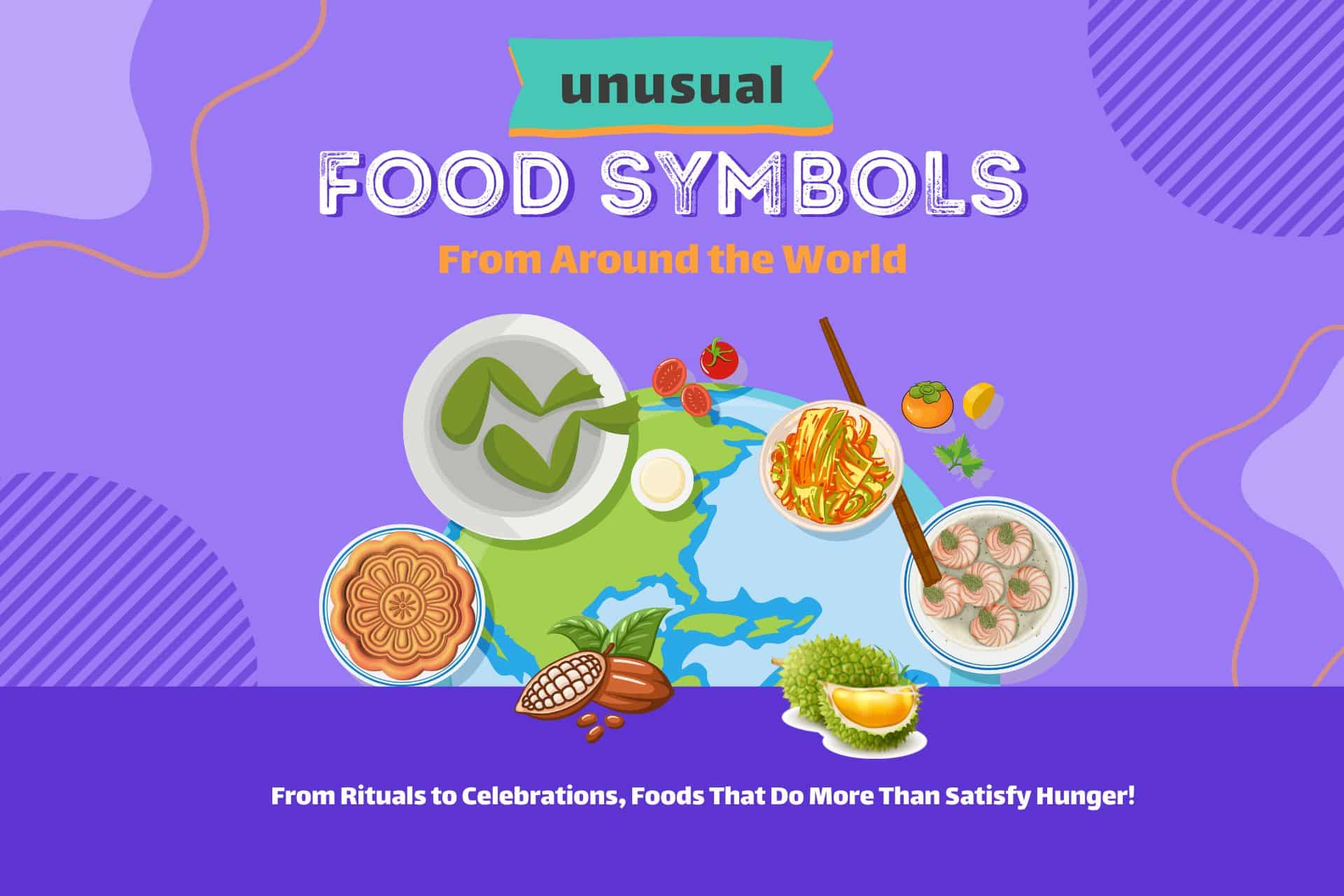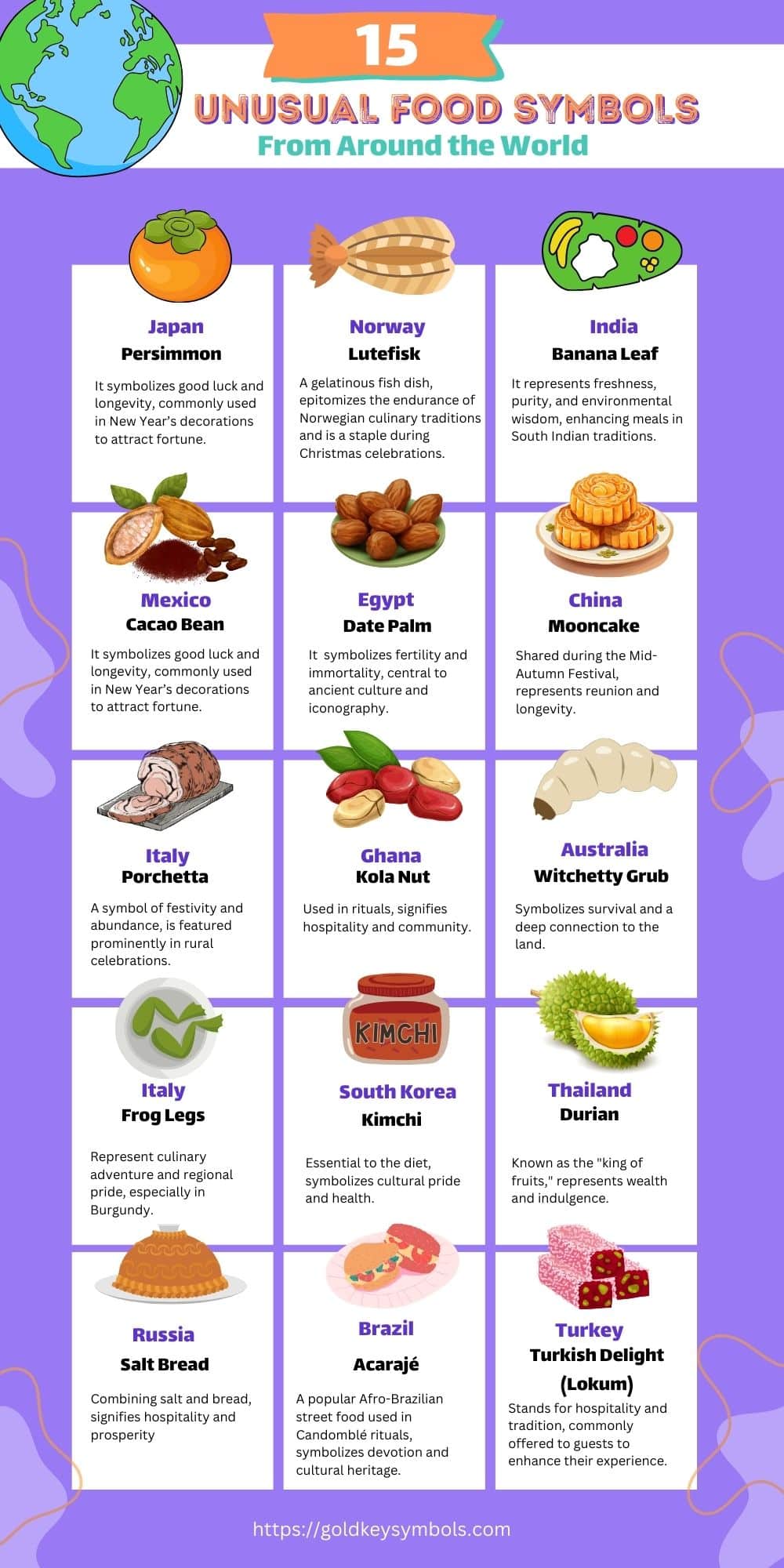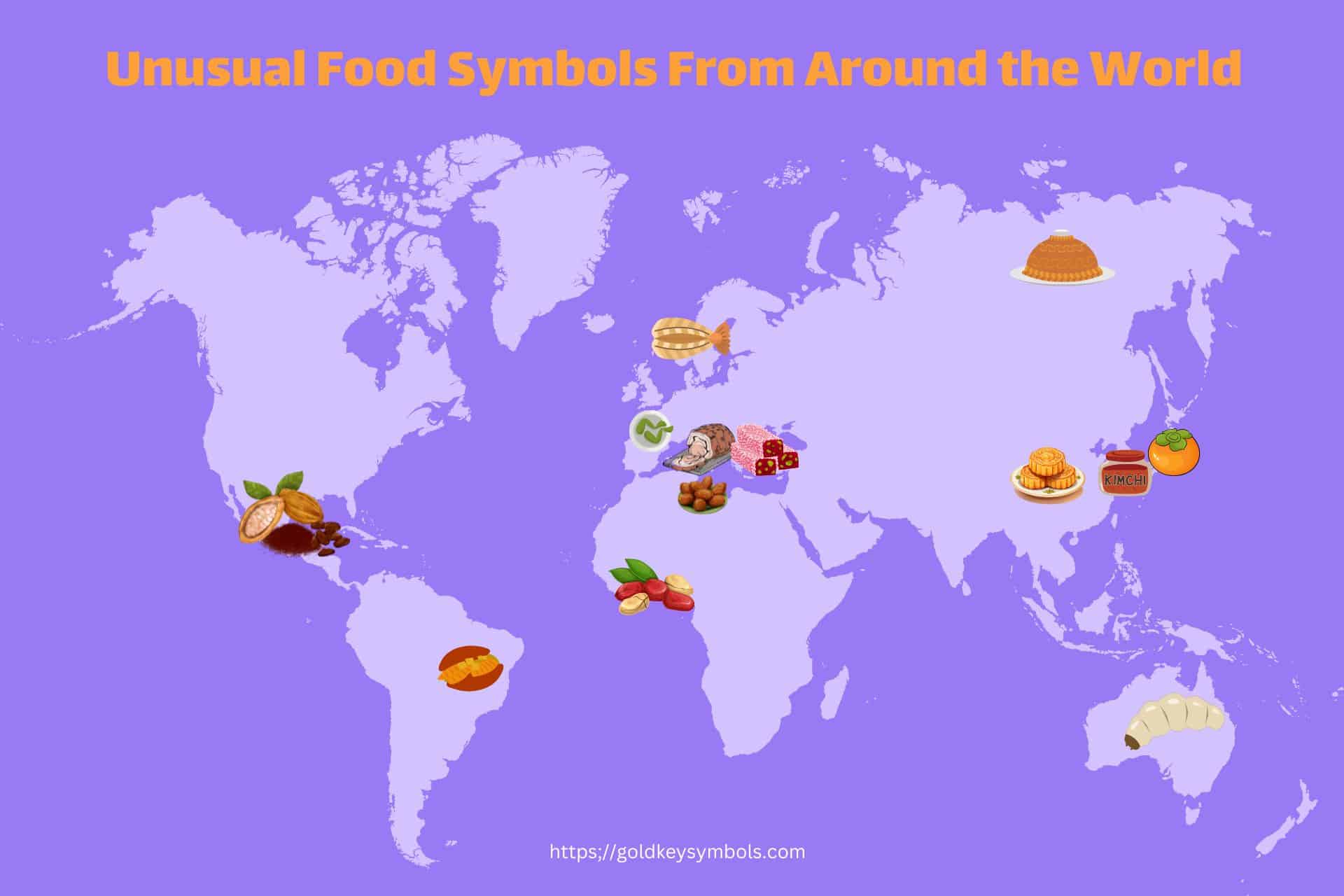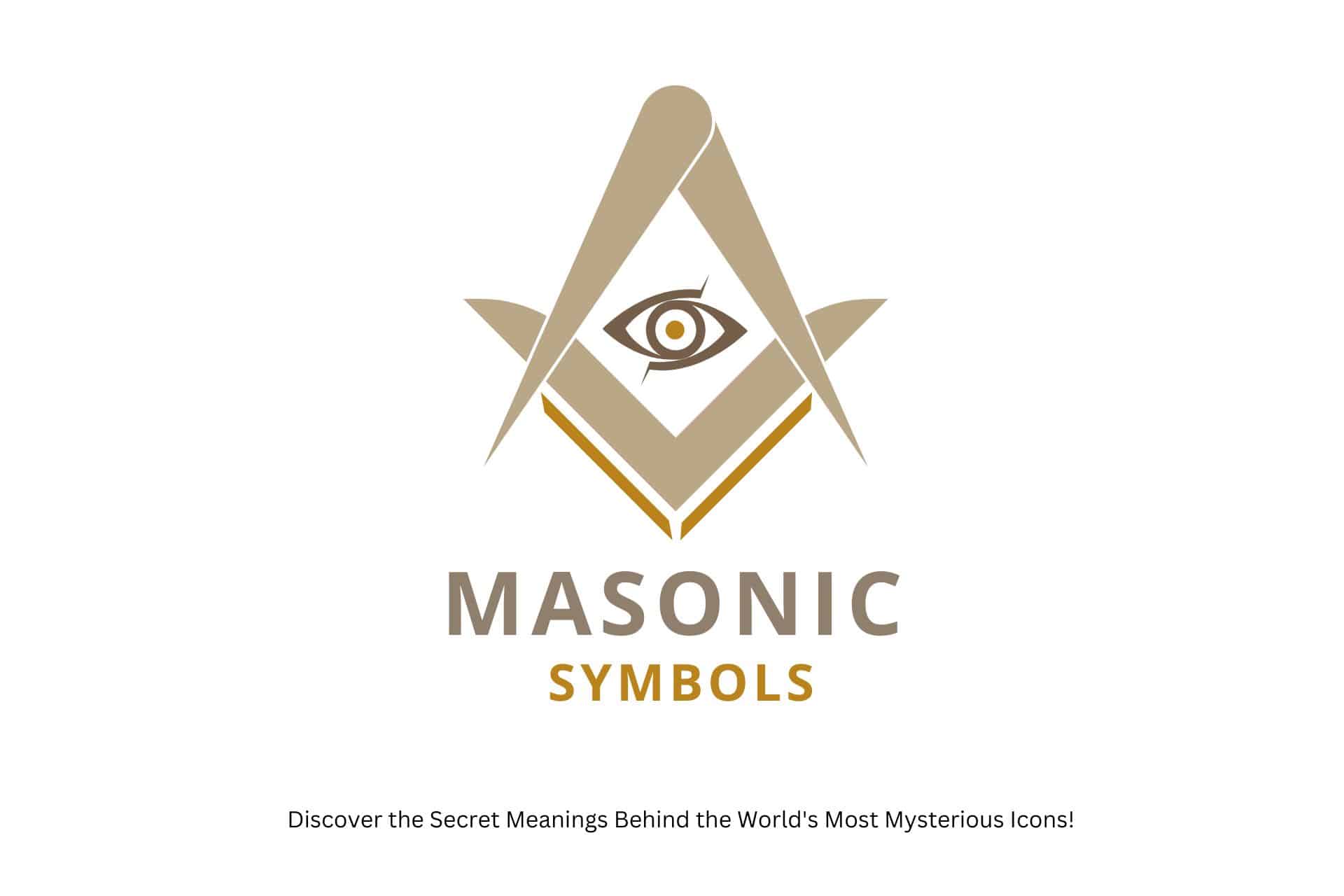From Rituals to Celebrations, Foods That Do More Than Satisfy Hunger!
Are you curious about the hidden meanings of unusual food symbols across cultures? Have you ever wondered why Italy’s pasta shapes symbolize love and longevity or how Japan’s mochi signifies good fortune?
Perhaps you’re baffled by the rice grain tossed at Indian weddings symbolizing prosperity or why American apple pie oozes with hospitality.
If so, you’re in the right spot. This article unravels these culinary narratives, explaining their history, significance, and global variations.
You’ll gain an enriching understanding of unusual food symbols, strengthening your respect and appreciation for international cultures.
So, are you ready to decipher these unusual food symbols from around the world? Keep reading to unlock these delectable secrets!
Let’s get started!

Here’s What You Will Find

Key Takeaways
Unusual Food Symbols
Symbolic Richness: Food items often carry profound symbolic meanings beyond their nutritional value. These symbols are deeply embedded in cultural narratives, rituals, and everyday practices, reflecting broader themes such as prosperity, health, and communal identity.
Cultural Universality: Every culture worldwide has unusual food symbols, each unique yet serving similar purposes of representing values, beliefs, or traditions. Whether it’s an apple’s health implications or rice’s communal importance, these symbols are integral to cultural expressions and communal bonding.
Beyond Consumption: Food symbols are not just for consumption; they play crucial roles in festivities, rituals, and daily life. They are used to express and communicate cultural values and are often pivotal in ceremonies and traditional practices, serving as a medium for passing heritage across generations.
Explorative Invitation: Recognizing the symbolic meanings behind food encourages us to explore and appreciate the rich tapestry of global cultures. Understanding these symbols offers insight into how communities around the world view the world, interact with it, and make sense of it through the lens of food.
What is a Food Symbol?
A food symbol refers to a food item with a more profound connotation or a specific message. It’s not merely about the food itself; instead, it’s about its underlying significance.
Food symbols are found in every culture, each boasting a unique set of symbolic foods. Some are common and easily recognized, while others might seem unusual to outsiders.
These symbolic foods play a crucial role during various occasions – they could be part of grand festivities, integral to certain rituals, or simply a part of daily existence. They serve as a medium to express values, beliefs, or hopes.
To put it into perspective, consider these examples:
- When biting into an apple, you’re not just enjoying its sweetness. The apple is a universal symbol of health and knowledge. It can be traced back to the biblical story of Adam and Eve, where the apple represented the forbidden fruit from the Tree of Knowledge. In modern times, the phrase ‘an apple a day keeps the doctor away’ further reinforces the apple’s symbolism of health.
- If you’re indulging in a bowl of rice, it’s not merely about satisfying your hunger. Rice is a symbol of prosperity and abundance in many cultures. In Asian societies, rice is deeply embedded in daily life and traditions. It’s a staple food that ensures survival, symbolizing sustenance and fertility.
Next time you sit down for a meal, remember that you’re not just savoring the flavors of the food. You’re stepping into a world of meaning. Each bite can represent a story, a tradition, a value, or a belief.
So, remember to appreciate the taste and rich symbolism that your food might represent.
Historical and Cultural Meaning of Unusual Food Symbols
Across the globe, countless foods hold historical and cultural meanings that may appear peculiar to outsiders yet are deeply significant within their native societies. As you seek the freedom to explore these intriguing symbols, you should keep four key concepts in mind:
Food isn’t merely sustenance – it’s a tapestry woven with tales of the past and shared values.
Food, in its essence, isn’t simply a source of nutrition. It’s much more than that. It’s a symbol, a story, a historical record that transcends generations. Every ingredient, preparation method, and tradition tells a story about a community’s shared experience, values, and beliefs. This is why food is often considered the heart of culture. For example:
- Eating mochi (rice cake) on New Year’s Day is associated with good fortune and longevity in Japan.
- In many Native American tribes, corn is more than a staple food; it is also a sacred element in religious ceremonies.
- In Greece, breaking bread is considered a symbol of friendship and trust.
Each dish carries a narrative, often steeped in tradition, shaping the identity of a people.
Every dish has a story to tell. It might be a centuries-old tradition passed down from generation to generation or a recent innovation borne out of necessity. The narrative behind a dish often shapes the identity of a society, serving as a reflection of its history, geography, and cultural values. Examples include:
- The English Christmas pudding is a dish steeped in medieval tradition.
- The Moroccan couscous is a symbol of hospitality and communal eating.
- The Indian curry reflects the country’s rich spice trade history.
Unusual food symbols might seem odd, but they’re a rich source of cultural insight.
What may seem unusual or peculiar to an outsider often holds deep meaning within its native culture. These unusual food symbols can illuminate different societies’ unique traditions, customs, and values. For instance:
- The Chinese Century Egg symbolizes longevity and good health.
- The Italian Spaghetti alla Puttanesca is a dish with a colorful and controversial history.
- The Mexican Day of the Dead bread is a sweet roll used in rituals to honor deceased loved ones.
Understanding these symbols can bridge gaps, fostering mutual respect and appreciation.
Understanding the cultural significance behind these unusual food symbols can help bridge cultural gaps and foster mutual respect and appreciation. This understanding can be achieved through traveling, reading, attending cultural festivals, or trying new foods. Doing so enriches our taste buds, cultural understanding, and appreciation. For example:
- Trying out traditional Japanese tea ceremonies can deepen one’s understanding of Japanese aesthetics and philosophy.
- Participating in a French wine tasting can provide insights into the French culture of leisure and pleasure.
- Attending an American Thanksgiving dinner is a way to understand the country’s history and values of gratitude and family.
Unusual Food Symbols from Around the World
Imagine yourself in the heart of Italy, captivated by the spiraled forks of pasta, a symbol of good fortune. Italy, the birthplace of pasta, has a rich history intertwined with this staple food. The twisted shapes aren’t just appealing to the eye, but they also hold a more profound meaning:
Each symbol carries its unique charm, distinctly molded by its cultural context. The world teems with various unusual food symbols, eagerly awaiting your exploration.
So, let your curiosity lead you on this journey!

Food does more than sustain us; it often carries deep symbolic meanings across various cultures. From signifying good fortune and longevity to representing hospitality and tradition, food symbols encapsulate societies’ values and beliefs.
Let’s explore fifteen fascinating and unusual food symbols from around the world.
- Japan: Persimmon
In Japan, the persimmon is more than just a sweet orange fruit; it is a herald of good luck and longevity. Commonly associated with New Year’s celebrations, it’s often used in decorations to attract fortune in the coming year. Its deep orange hue symbolizes a bright sun casting light on the new year. - Norway: Lutefisk
Lutefisk, a gelatinous fish dish made from lye-treated cod or other whitefish, is a quintessential part of Norwegian Christmas traditions. It represents the endurance of Norwegian culinary customs, connecting generations with the flavors of the past during the festive season. - India: Banana Leaf
The banana leaf is more than a biodegradable plate; in South Indian traditions, it symbolizes freshness, purity, and environmental wisdom. Serving food on banana leaves enhances the meal’s taste and aesthetic, echoing India’s deep-rooted connection to nature. - Mexico: Cacao Bean
The cacao bean holds a place of reverence in ancient Mesoamerican cultures; it was once used as currency and was considered sacred. Today, it continues to be a symbol of life and fertility, celebrated in rituals and everyday consumption. - Egypt: Date Palm
The date palm is a pivotal element in ancient Egyptian culture. Its fruit and tree are depicted in many hieroglyphs, illustrating its importance in earthly life and the afterlife. - China: Mooncake
Mooncakes are not just a treat; they symbolize reunion and longevity in Chinese culture, especially during the Mid-Autumn Festival. These pastries are shared among family and friends to honor lunar appreciation and moon-watching traditions. - Italy: Porchetta
Porchetta, a savory, fatty, and moist boneless pork roast, is a symbol of festivity and abundance in Italian culture, particularly noted during public celebrations and festivals in rural regions. Its rich flavor and communal preparation style reflect the heartiness of Italian gatherings. - Ghana: Kola Nut
In many West African cultures, the kola nut is used in rituals and as a symbol of hospitality and social ceremonies. It is offered to guests and dignitaries as a gesture of welcome and respect, carrying meanings of friendship and community. - Australia: Witchetty Grub
An Aboriginal bush food, the witchetty grub symbolizes survival and the profound connection to the land. This grub, rich in protein, is a staple in the indigenous diet and a component of many traditional rites and stories. - France: Frog Legs
Frog legs might seem unusual, but they symbolize culinary adventure and regional pride in France, especially in areas like Burgundy. This delicacy reflects the French flair for transforming simple ingredients into haute cuisine. - South Korea: Kimchi
Kimchi is a staple in Korean diets and carries significant cultural pride. Known for its health benefits, kimchi represents the preservation of Korean culinary traditions and the importance of food in communal and family life. - Thailand: Durian
Often called the “king of fruits,” durian is celebrated for its distinctive aroma and flavor. In Thai culture, wealth and indulgence symbolize a luxury to be enjoyed and shared among friends and family. - Russia: Salt Bread
Salt bread, presented to guests, combines the robust symbols of salt and bread. Salt, with its preserving qualities, and bread are staples of life, and together, they represent hospitality, health, and prosperity in Russian culture. - Brazil: Acarajé
Acarajé, a popular Afro-Brazilian street food, is deeply embedded in the rituals of Candomblé, where it serves as an offering to deities. This symbolizes devotion and heritage, bridging the earthly with the spiritual. - Turkey: Turkish Delight (Lokum)
Turkish Delight, or Lokum, flavored with rosewater and lemon, stands for hospitality and tradition in Turkish culture. It is traditionally offered to guests to sweeten their experience, epitomizing the Turkish emphasis on warmth and generosity in hosting.
Each food symbol carries profound cultural narratives, telling stories of heritage, tradition, and communal values that transcend the mere act of eating. They invite us to look deeper into the plates and palates of the world, uncovering the rich tapestry of human culture through food.
Modern Usage and Representation
Exploring modern representation, it’s intriguing to witness ancient food symbols’ evolution and adaptation to contemporary culture. These symbols’ creative interpretations and uses in daily life are varied and often surprising.
Food symbols anchor tradition, culture, and dynamic elements in modern branding, tourism, and cultural identity. In an era of rampant globalization and cultural exchange, these symbols have found new life in various modern contexts, influencing advertising, popular culture, and political discourse.
Let’s explore how unusual food symbols are utilized in contemporary settings and their impact on a global audience.
Branding and Marketing
Many businesses have harnessed the power of unusual food symbols to create strong brand identities and marketing strategies. For instance, using the cacao bean in branding for chocolate companies is not just about indicating a product’s primary ingredient but also evoking its exotic origins and artisanal qualities.
Luxury chocolate brands often emphasize using authentic cacao to associate their products with purity and premium quality.
Similarly, kimchi has been adopted by various health food brands in the West, symbolizing probiotic health benefits and authentic Korean culinary heritage, appealing to health-conscious consumers and cultural explorers alike.
Tourism and Cultural Promotion
Tourism boards worldwide use unusual food symbols to promote their regions and strengthen their cultural identities. For example, despite its controversial smell, durian is celebrated in Southeast Asia with festivals and tours that attract durian enthusiasts from around the globe.
Thailand and Malaysia use the durian to symbolize their unique food offerings and lure tourists. In Australia, the witchetty grub is featured in cultural and wildlife tours to highlight indigenous food practices and attract adventurous eaters interested in authentic Aboriginal experiences.
Cultural Identity and Festivals
Food symbols play a crucial role in festivals and cultural events, where they help strengthen community ties and reaffirm cultural identities. The mooncake is central to China’s Mid-Autumn Festival, not just as a treat but as a symbol of reunion and sharing.
Global communities, including Chinese diasporas, engage in mooncake-making activities that help younger generations connect with their heritage. In Japan, persimmon is used in New Year decorations and appears in artwork and literature associated with autumn and the changing seasons, reinforcing its role in Japanese cultural symbolism.
Popular Culture and Media
In popular culture, these unusual food symbols often appear in films, television shows, and books, where they help create a sense of place or convey cultural nuances.
Numerous American cartoons and films playfully depict French frog legs, sometimes stirring controversy but often highlighting France’s adventurous culinary spirit. Brazilian acarajé has been featured in novels and stories that discuss Afro-Brazilian culture, serving as a literary device to explore themes of identity and resilience.
Advertising
Advertising campaigns frequently utilize unusual food symbols to convey simplicity, nostalgia, or exoticism. Turkish Delight, for example, is often marketed in the West as an exotic sweet from the oriental markets of Istanbul, appealing to consumers’ fantasies about the East.
This has helped Turkish Delight become synonymous with indulgence and mystery, spurred partly by its literary mention in C.S. Lewis’s “The Chronicles of Narnia.”
Through these various channels, unusual food symbols transcend traditional contexts to influence modern life and culture. They remind us of our shared human experience centered around food and highlight the diverse ways our eating habits are interconnected with global cultural narratives.
This seamless integration of old traditions into new worlds showcases unusual food symbols’ enduring power and appeal in connecting us across time and space.

Symbolism in Art and Literature
Venturing into art and literature, one will discover a rich tapestry of unusual food symbols woven into narratives and artworks. These symbols often carry profound meanings and offer valuable insights into human existence. They aren’t just decorative elements but gateways into broader themes of liberation, choice, and the human condition.
- The Apple in the Biblical Tale of Adam and Eve: The apple is a potent symbol in the biblical story of Adam and Eve. It’s not just a fruit but a symbol of knowledge and the freedom to choose. This humble fruit, according to the tale, was the catalyst for humanity’s fall from grace and the beginning of human understanding of good and evil. Adam and Eve exercised their free will by eating the apple, albeit with dire consequences. This symbol has permeated our culture and literature, reminding us of the power and perils of knowledge and choice.
- Proust’s Madeleine: In Marcel Proust’s seven-volume novel, ‘In Search of Lost Time,’ the humble Madeleine, a small French cake, symbolizes memory and nostalgia. When the narrator dips the madeleine into his tea, the taste triggers a torrent of memories, taking him back to his childhood. This act of remembering, sparked by a simple piece of cake, explores the theme of involuntary memory, showing how our past can unexpectedly resurface, triggered by sensory experience.
- Grapes in Renaissance Art: Grapes, often depicted in Renaissance art, symbolize abundance, fertility, and freedom. Artists used grapes as a metaphor for the bountiful gifts of nature and abundant life during this period. Some interpretations also link grapes to liberty, as they grow freely on vines, unconstrained and plentiful.
- Bread in Literature: Bread, a universal staple food, is often employed as a literary symbol. It represents sustenance, life, and in some contexts, communal unity. From tales of breaking bread in biblical texts to the hunger and deprivation shown in dystopian novels, bread is a powerful metaphor. It’s a symbol that transcends cultures, reminding us of our shared need for nourishment and connection.
To truly appreciate art and literature, one must explore the world of symbols, understand their depth, and savor the flavor they add to these mediums. The symbols open new dimensions of understanding, allowing us to perceive beyond the literal and into the symbolic, enriching our experience of art and literature.
Frequently Asked Questions
How Do Food Symbols Influence Our Dietary Choices?
Food symbols subtly shape your eating habits. They can sway you towards certain foods for health or cultural reasons. It’s all about the power of suggestion, and you’re not always conscious of its influence.
Can Food Symbols Have Different Meanings in Different Countries?
Yes, food symbols can hold different meanings in various countries. You’re free to interpret them as you wish. Remember, your personal experiences and cultural background will shape your interpretation of these symbols.
Are There Any Unusual Food Symbols That Are Considered Bad Luck or Taboo?
Yes, there are. In Japan, sticking chopsticks upright in rice is seen as bad luck. In many cultures, certain foods or ways of serving them can symbolize misfortune or even death.
Do Any Unusual Food Symbols Exist in Contemporary Pop Culture?
Sure, you’ve seen it in pop culture. Pineapple on pizza is a contentious symbol, sparking debates. ‘Blue’ food isn’t natural, causing unease. And let’s not forget how kale suddenly became a superfood symbol.
What Are the Psychological Influences of Food Symbolism?
Food symbolism constantly influences us. It can evoke emotions, memories, and desires. Advertising often uses it to trigger our subconscious, making us crave certain foods or associate them with specific feelings or experiences.
Last Thoughts
So, you’ve journeyed through the captivating domain of unusual food symbols. Food symbolism is deeply ingrained in our cultures, whether it’s a lucky rabbit’s foot in America or Japan’s mochi for New Year’s.
Unsuarl food symbols tell stories, evoke emotions, and are represented in art and literature. Keep exploring, and you might just discover a new layer of connection with different cultures through their unique food symbols.
Before You Go
We hope you found this journey through the world of food symbols as fascinating as we did. If you did, why not share it with others? Learning about different cultures and their traditions can help foster understanding and respect. Plus, you never know who might find this topic just as enjoyable.
So go ahead and share this article with your friends and family.
More on Food Symbols
Food Symbols Unlocked: The Shocking Symbolism of the Food You Can’t Resist!
Find What Your Dinner Plate Reveals About Ancient Myths! Are you a food enthusiast puzzled by various food symbols? Do you often wonder about the meaning behind vegetarian, vegan, or gluten-free indicators or what an …
Check it Out!More on Symbols
History of Symbols: How Ancient Marks Shape Our Modern World!
From Cave Walls to Emojis—A Journey Through Time Have you ever wondered about the history of symbols? Maybe you’ve wondered about their global variations or how they’ve shaped our world. Prepare to have your curiosity …
Check it Out!Tattoos and Their Secret Powers: How Ink Can Change Your Life!
Exploring the Art, Meaning, and Culture of Ink! Are you intrigued by tattoos? Are you curious about the stories they tell and the intricate details they contain? Look no further. You might be wondering about …
Check it Out!Masonic Symbols Unlocked: Discover the Secret Meanings Behind the World’s Most Mysterious Icons!
The Hidden Powers and Ancient Secrets You Never Knew! Are you intrigued by masonic symbols and their profound meanings? Perhaps you’ve seen the square, compasses, or the all-seeing eye and wondered about their significance? Thankfully, …
Check it Out!Military Insignia: Unlock the Hidden Meanings Behind These Powerful Symbols
From Zero to Hero: Uncover How Military Insignia Define Power and Prestige Are you curious about the meaning behind military insignia or rank emblems? Have you ever wondered about their significance or history? This comprehensive …
Check it Out!More Symbols


















